Fresno is a great place to observe birds. It is situated in the San Joaquin Valley, at the southern end of California’s Central Valley. The San Joaquin River runs through the city, and there are many parks and open spaces that attract a variety of birds.
The mild climate of Fresno makes it a great place for bird-watching year-round. From the American Kestrel to the Yellow-billed Magpie, the city is home to a wide variety of birds.
With its diverse habitats, Fresno is a great place to observe a variety of birds, both resident and migratory. Whether you’re a beginner or an experienced bird-watcher, Fresno has something to offer you.
1. Mourning Dove
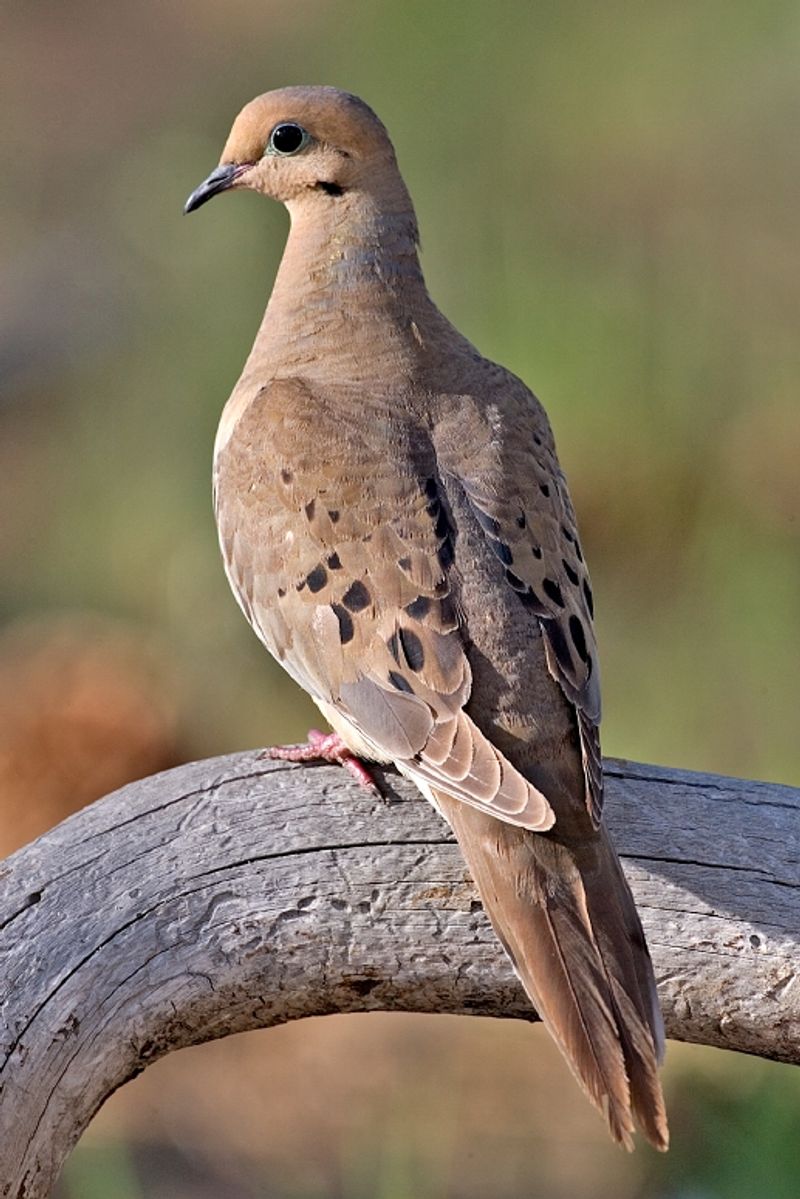
The mourning dove is a bird belonging to the Columbidae family, which is commonly known as the dove family. It is commonly referred to as the American mourning dove, the rain dove, and colloquially as the turtle dove.
In the past, it was referred to as the Carolina pigeon and Carolina turtledove. This bird is found throughout the United States and Canada and is widely seen in many other countries across the world.
It has a distinct appearance, with its grayish-brown body and white spots on its wings. The mourning dove is known for its unique call, which is a series of coos and is often heard in the morning and evening.
Its diet consists mostly of seeds, but it also eats fruits, berries, and insects. It builds its nests on trees and other tall structures, typically laying two white eggs. This species of dove is considered to be a symbol of peace and mourning, hence its name.
| Kingdom | Animalia |
| Phylum | Chordata |
| Class | Aves |
| Order | Columbiformes |
| Family | Columbidae |
| Genus | Zenaida |
| Species | Z. macroura |
2. California Quail
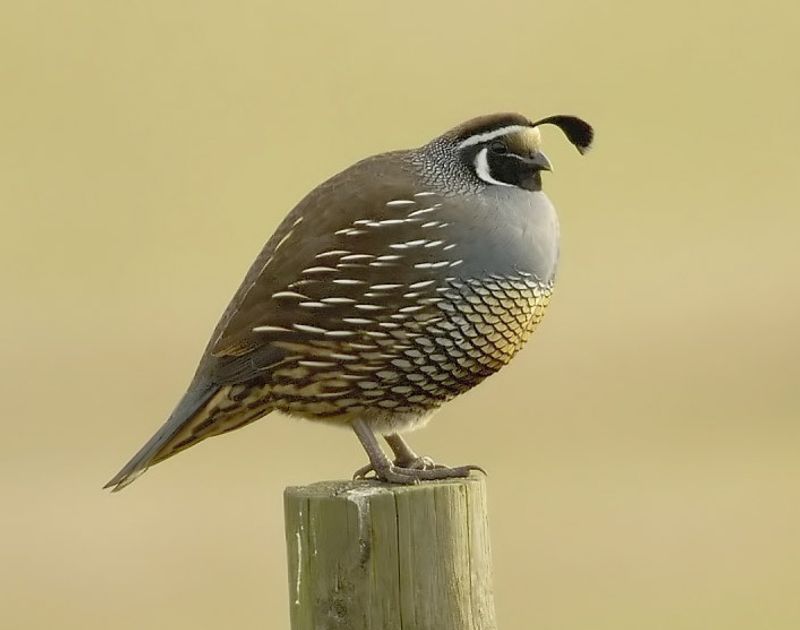
The California quail is a small bird that belongs to the New World quail family. It is also known as the Valley quail or California Valley quail. The male California quail has a black, curved crest made of six feathers that droop forward, while the female has a brown crest.
The flanks of the quail are brown with white streaks. This species of quail is a ground-dweller and is often found in small flocks. They feed on seeds, berries, insects, and other small invertebrates.
California quail are well-adapted to living in a variety of habitats, from deserts to woodlands, and can often be found in urban parks and gardens. They are a hardy species and can tolerate a wide range of temperatures and climates.
They are generally active during the day, when they search for food, and rest in the safety of vegetation at night.
| Kingdom | Animalia |
| Phylum | Chordata |
| Class | Aves |
| Order | Galliformes |
| Family | Odontophoridae |
| Genus | Callipepla |
| Species | C. californica |
3. House Finch
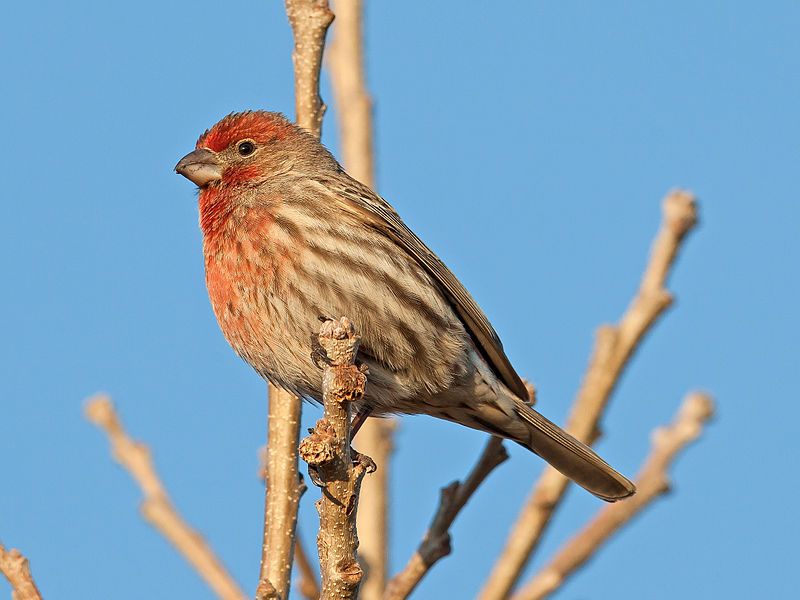
The house finch is a member of the Fringillidae family, commonly known as the finch family. This species is native to western North America but has been introduced to the eastern half of the continent and to Hawaii.
The house finch belongs to the genus Haemorhous, which also includes two other species of American rosefinches. This genus is distinguished by its unique beak shape and its natural habitat in western North America.
The house finch is a small bird with a brown body and a bright red or orange head and breast. Its diet consists mainly of seeds, berries, insects, and nectar. The house finch is a sociable bird that lives in small flocks and is often seen around bird feeders and in parks.
It is a popular species among birdwatchers, and the males are known for their beautiful songs.
| Kingdom | Animalia |
| Phylum | Chordata |
| Class | Aves |
| Order | Passeriformes |
| Family | Fringillidae |
| Genus | Haemorhous |
| Species | H. mexicanus |
4. White-winged Dove
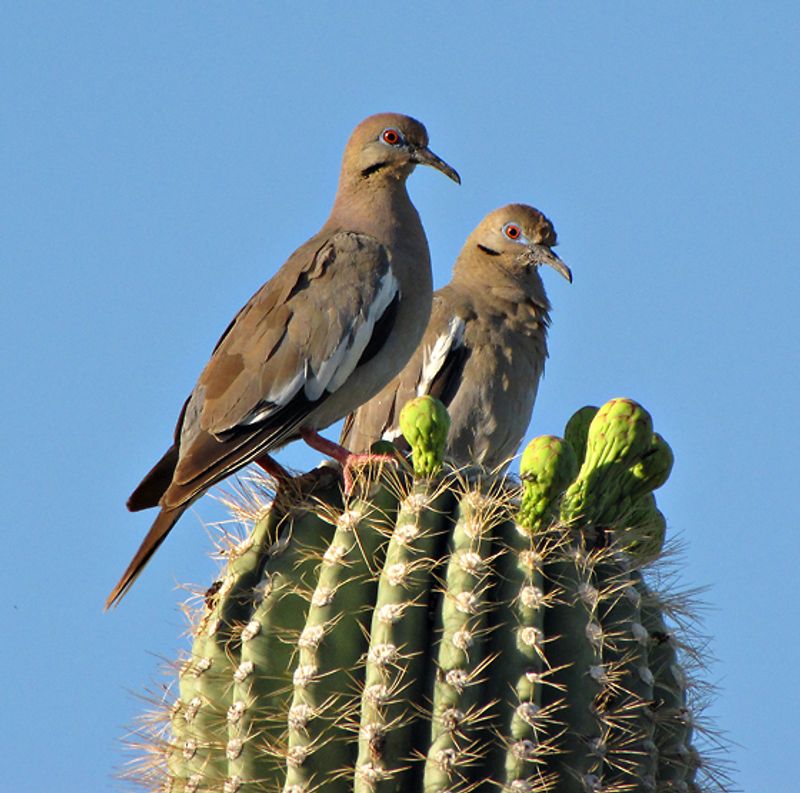
The white-winged dove is a species of dove found in the Southwestern United States, Mexico, Central America, and the Caribbean. It is a relatively large dove, measuring between 12 and 14 inches in length.
The white-winged dove is easily distinguished from other species of dove by the white edge of its wings. This white edge is visible even when the wings are folded. Additionally, the white-winged dove has a bright blue eyering around its eyes, and its eyes are bright red.
The combination of these features makes the white-winged dove a very unique and easily identifiable bird.
| Kingdom | Animalia |
| Phylum | Chordata |
| Class | Aves |
| Order | Columbiformes |
| Family | Columbidae |
| Genus | Zenaida |
| Species | Z. asiatica |
5. Great Blue Heron
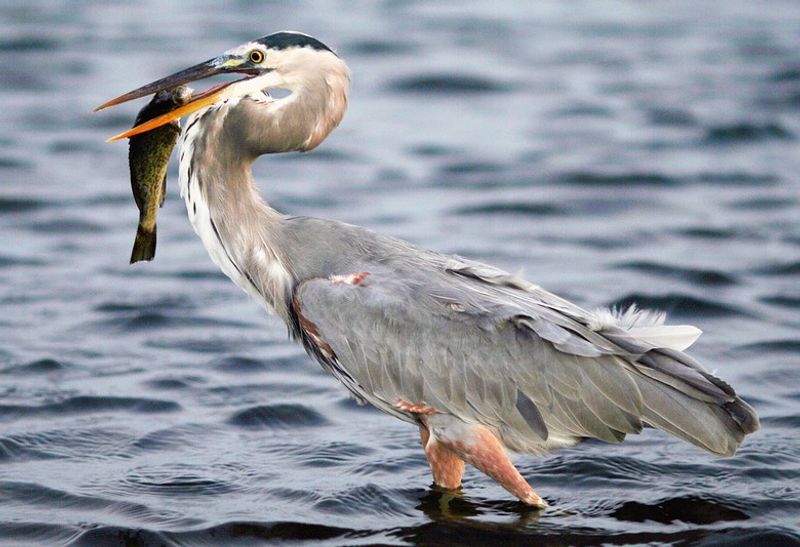
The great blue heron is a majestic bird, with a wingspan up to 6 feet wide. It is a member of the heron family Ardeidae, and can be found in various habitats across North and Central America, as well as far northwestern South America, the Caribbean, and the Galápagos Islands.
These large, wading birds prefer to be near the shoreline of open water, such as lakes, ponds, and rivers, and they can also be seen in wetlands. The great blue heron is a solitary bird, usually only seen in pairs or a small group during the breeding season.
It is a powerful hunter, with a long, sharp bill that it uses to capture fish, amphibians, and other aquatic prey. This species is also known to feed on insects, birds, and small mammals.
The great blue heron is a majestic sight to behold, with its beautiful colors and impressive wingspan. Its presence is a reminder of the beauty and diversity of nature.
| Kingdom | Animalia |
| Phylum | Chordata |
| Class | Aves |
| Order | Pelecaniformes |
| Family | Ardeidae |
| Genus | Ardea |
| Species | A. herodias |
6. Anna’s Hummingbird
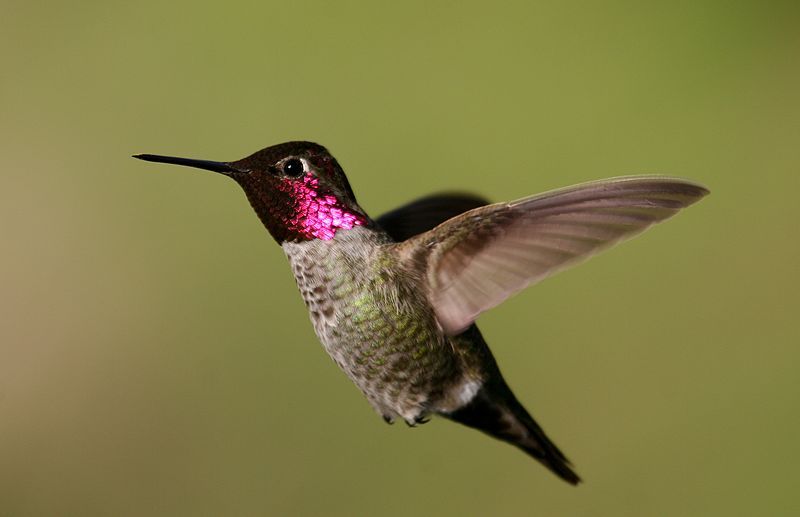
Anna’s hummingbird, a species native to western coastal regions of North America, is named after Anna Masséna, Duchess of Rivoli. It is a small bird characterized by a reddish-pink gorget (throat patch) and a large rounded tail.
The colors of the bird range from green, to pink, and white. It is a nectarivore; it feeds on nectar from flowers and small insects. In the early 20th century, Anna’s hummingbirds were only found breeding in the northern part of Baja California and in Southern California.
It has since expanded its range, with sightings now being reported in Texas, Arizona, Nevada, and even as far north as British Columbia.
The species is now more widely distributed, but it remains concentrated in the western United States. Despite its increasing range, Anna’s hummingbird is still threatened by habitat destruction and climate change.
The species is also vulnerable to competition with introduced species, such as the European Starling, that can outcompete it for food and nesting sites.
Conservation efforts are being taken to protect the species, including habitat restoration, education, and the protection of their known breeding grounds in California.
| Kingdom | Animalia |
| Phylum | Chordata |
| Class | Aves |
| Clade | Strisores |
| Order | Apodiformes |
| Family | Trochilidae |
| Genus | Calypte |
| Species | C. anna |
7. Ring-necked Duck
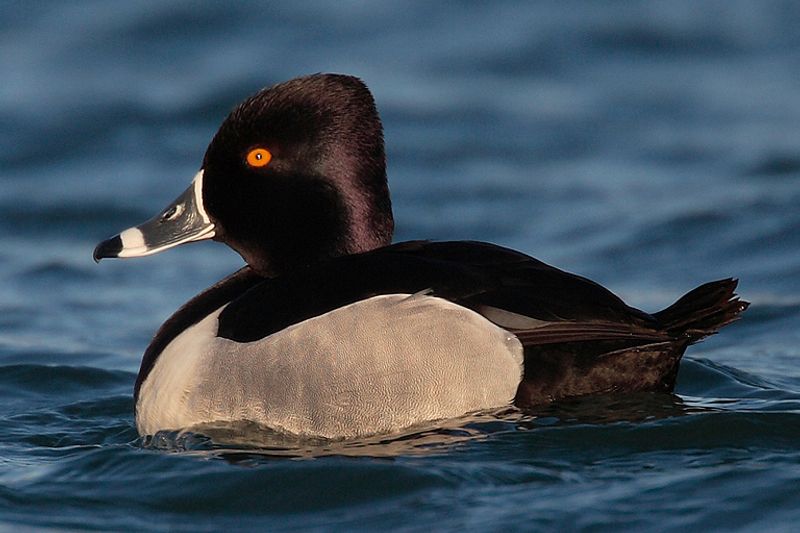
The ring-necked duck is a diving duck native to North America. It is commonly spotted in freshwater ponds and lakes. The scientific name of the duck is derived from two Latin words: aithuia and collaris.
Aithuia is an unidentified seabird that was written about by ancient authors such as Hesychius and Aristotle. Collaris is a Latin word that refers to the neck. This is because the collum, which is the root of collars, means neck.
The scientific name is thus a combination of two words that refer to the neck of the duck and an ancient bird that is unidentified.
In general, the scientific name of the ring-necked duck is a representation of its distinctive physical features and a reference to the ancient seabird which is mentioned in literature.
| Kingdom | Animalia |
| Phylum | Chordata |
| Class | Aves |
| Order | Anseriformes |
| Family | Anatidae |
| Genus | Aythya |
| Species | A. collaris |
8. California Gull
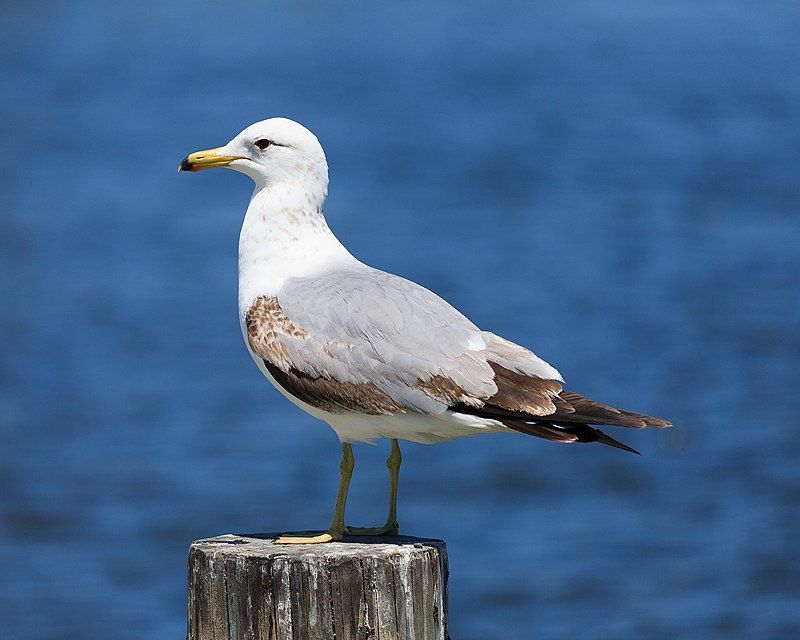
The California gull is a species of gull that is found up and down the Western coast of North America. It is a medium-sized bird, slightly smaller than the herring gull but larger than the ring-billed gull.
It has a distinctive yellow bill with a black ring, which helps to differentiate it from other gull species. The California gull is known to breed inland, as well as along the coast. It is a migratory species, returning to the same breeding grounds each year.
Its diet includes insects, small fish, and carrion, and it is known to scavenge food from human settlements. The California gull is an important species in its range, playing a vital role in the ecosystem.
| Kingdom | Animalia |
| Phylum | Chordata |
| Class | Aves |
| Order | Charadriiformes |
| Family | Laridae |
| Genus | Larus |
| Species | L. californicus |
9. Rock Pigeon
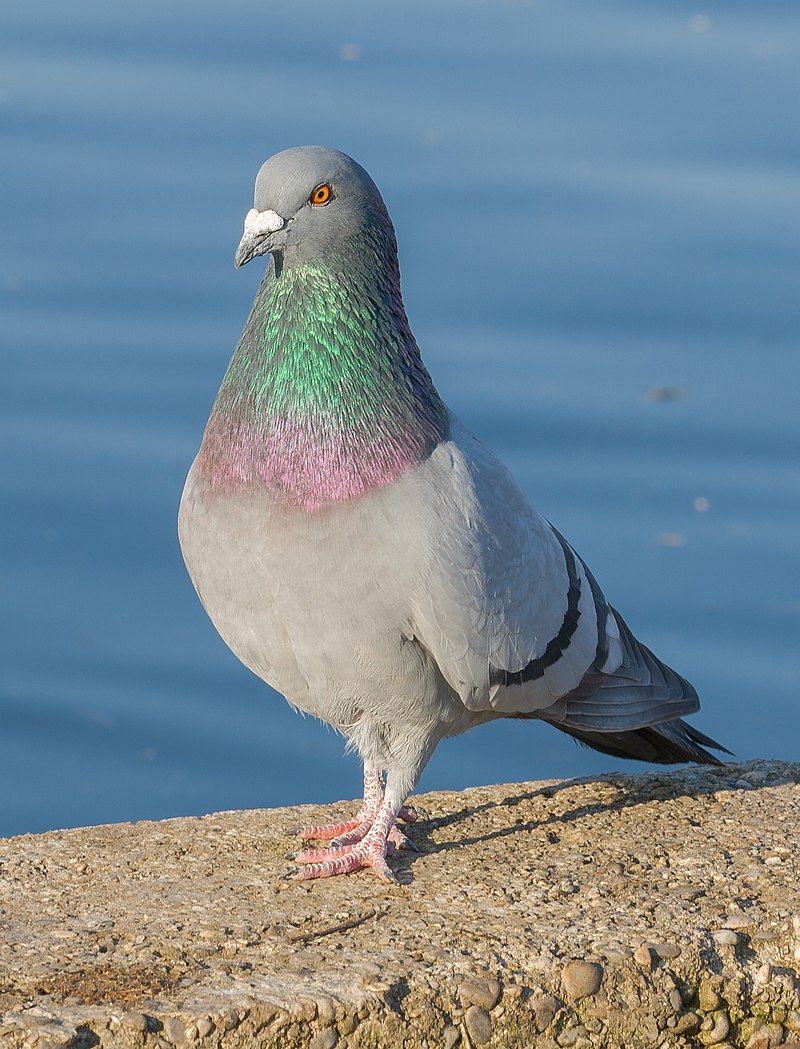
The rock dove, rock pigeon, or common pigeon is a species of bird that belongs to the family Columbidae. This species is commonly referred to as the “pigeon” in everyday language.
The domestic pigeon is a descendant of the rock dove, as it has been bred from this species over time. However, some of these domestic pigeons have escaped and have been released into the wild.
This has caused an increase in the number of feral pigeons in many parts of the world. Feral pigeons are those that have been released into the wild and are now living in their natural environment.
These pigeons are often seen in cities, near parks, and on buildings, as they are very adaptable.
The presence of domestic pigeons in the wild has also caused an increase in the competition for resources, such as food and shelter, as well as the risk of disease spread between the two populations.
| Kingdom | Animalia |
| Phylum | Chordata |
| Class | Aves |
| Order | Columbiformes |
| Family | Columbidae |
| Genus | Columba |
| Species | C. livia |
10. Dark-eyed Junco
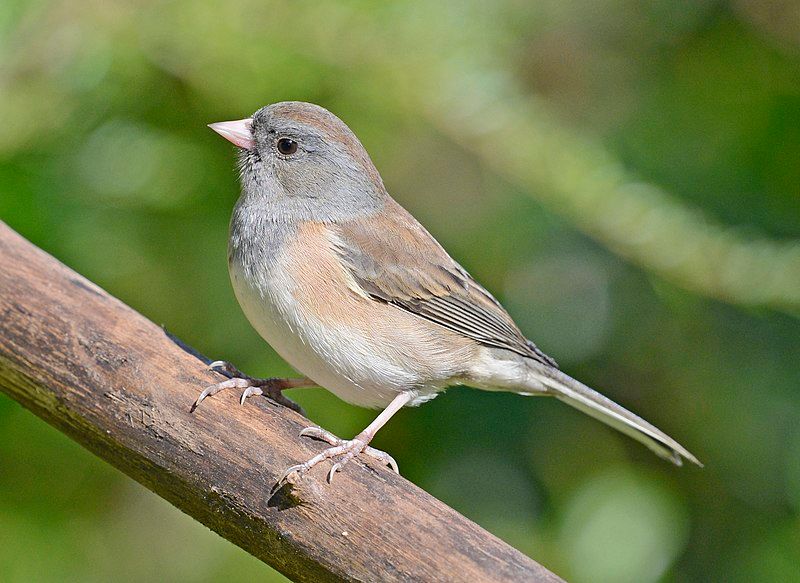
The dark-eyed junco is a species of bird that belongs to the junco family, which consists of small, grayish sparrows from the New World.
This species of junco is quite common in temperate habitats of North America, and during the summer months, some of them can be found in the Arctic regions.
The dark-eyed junco is a very variable species, with physical differences between individuals, just like its relative species, the fox sparrow. Despite its wide distribution, the systematics of this species are still not completely understood.
| Kingdom | Animalia |
| Phylum | Chordata |
| Class | Aves |
| Order | Passeriformes |
| Family | Passerellidae |
| Genus | Junco |
| Species | J. hyemalis |
11. Yellow-rumped Warbler
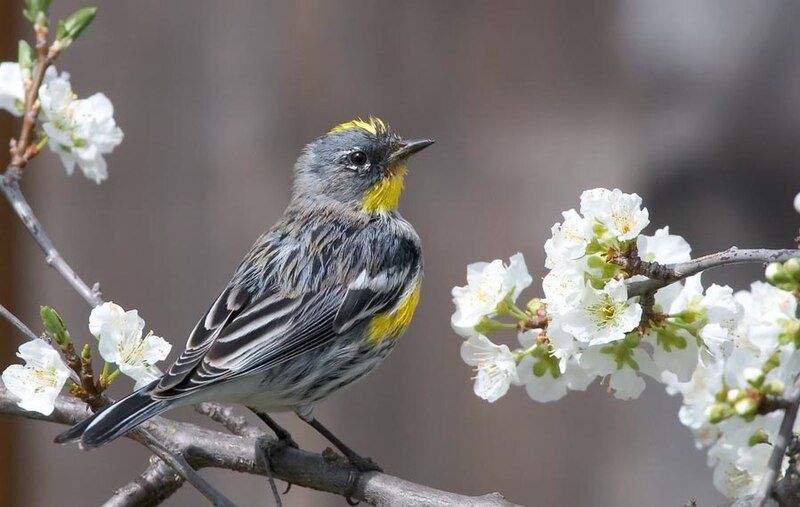
The yellow-rumped warbler is a species of bird that is native to North America and can be commonly seen in many locations across the continent. It is a migratory species, meaning that it moves from one area to another according to the season.
During the summer months, these birds can be found in parts of northern Canada, Alaska, and the northern United States.
During the winter, they typically migrate south to parts of Mexico, the Gulf Coast, and the Atlantic and Pacific coasts. This species of warbler is easily identifiable by its bright yellow rump, which is how it gets its name.
It also has a gray head and wings with white spots, and its back is a brownish color. The male and female yellow-rumped warblers look very similar, making it difficult to tell them apart. The yellow-rumped warbler is an omnivore, meaning that it eats both plants and animals.
It feeds on mostly insects, such as caterpillars, moths, and ants, as well as some fruit and seeds.
It is an active forager, meaning it can often be seen flitting from branch to branch or hovering in the air to catch insects. The yellow-rumped warbler is a popular species for birdwatchers.
Not only is it easy to identify, but it can be found in a variety of habitats, from deciduous forests and open meadows to grasslands and coastal areas. Its presence is a sign of a healthy and diverse bird population, making it an important indicator species.
| Kingdom | Animalia |
| Phylum | Chordata |
| Class | Aves |
| Order | Passeriformes |
| Family | Parulidae |
| Genus | Setophaga |
| Species | S. coronata |
12. Snow Goose
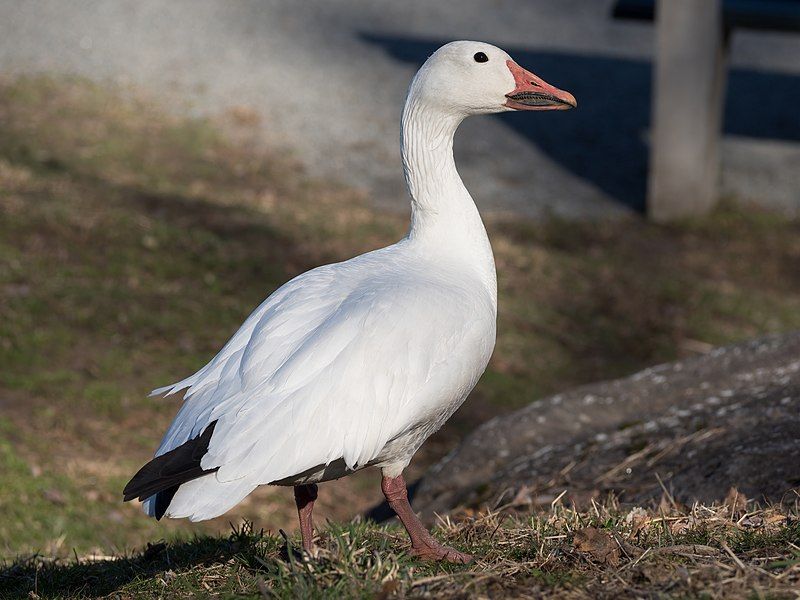
The snow goose is a species of goose native to North America. It is widely recognized for its white plumage, which is the source of its name. The species was previously classified in the genus Chen but has since been reclassified as a species of the “gray goose” genus Anser.
The snow goose can also come in a dark morph, which is often referred to as a blue goose. The morph of the snow goose may depend on its geographical location, as some snow geese in the northern regions tend to have darker plumage.
The snow goose is an iconic species of bird in North America and is a popular subject of study by wildlife biologists. It migrates extensively across the continent, often traveling in large flocks.
The snow goose is known to inhabit wetlands, grasslands, and tundras, and can be found in both coastal and inland areas. Its diet consists of a variety of grasses, grains, and aquatic vegetation. The snow goose is an important species for ecosystems in North America.
It helps to maintain healthy vegetation and wetlands, as well as provide food for other wildlife. The species is also a favorite for nature photographers and bird-watchers alike.
The snow goose is a species that is both unique and ecologically important, and its beauty adds to the natural beauty of North America.
| Kingdom | Animalia |
| Phylum | Chordata |
| Class | Aves |
| Order | Anseriformes |
| Family | Anatidae |
| Genus | Anser |
| Species | A. caerulescens |
13. Allen’s Hummingbird
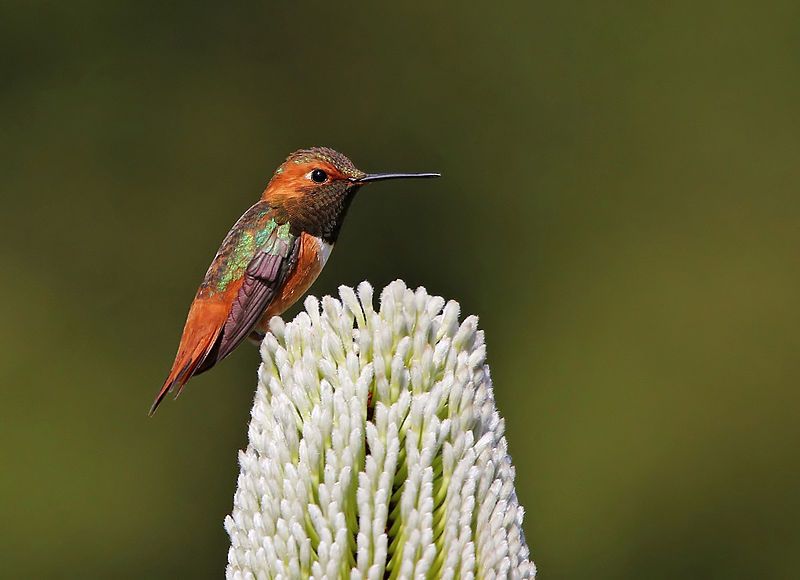
Allen’s Hummingbird is a species of hummingbird found in the western United States. It is a member of the genus Selasphorus, which is comprised of seven species. The Allen’s Hummingbird can be identified by its green back and flanks, and its white underparts.
The male of the species has a bright orange gorget, or throat patch, while the female has a duller gorget. The Allen’s Hummingbird is a small species, ranging from 3.5 to 3.9 inches in length, and weighing between 3 and 4 grams.
It is primarily a nectar feeder, but it also feeds on small insects. The Allen’s Hummingbird is a migratory species and can be found in the western United States during the summer breeding season. During the winter months, it can be found in Mexico and Central America.
The Allen’s Hummingbird is a common species and is not currently listed as endangered or threatened.
| Kingdom | Animalia |
| Phylum | Chordata |
| Class | Aves |
| Clade | Strisores |
| Order | Apodiformes |
| Family | Trochilidae |
| Genus | Selasphorus |
| Species | S. sasin |
14. Yellow-billed Cuckoo
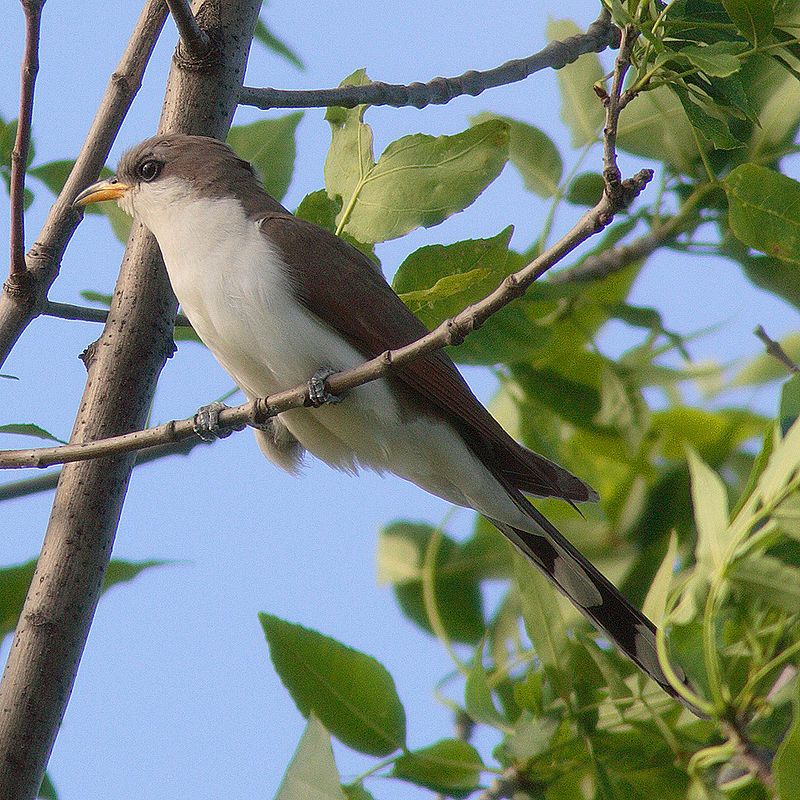
The yellow-billed cuckoo is a bird of the cuckoo family found in the southern United States. It is known by many folk names such as rain crow and storm crow. These names originate from the bird’s habit of calling on hot days, usually in anticipation of rain or thunderstorms.
This behavior has been observed by local people since ancient times, leading them to associate the bird with rain or storms. This connection between the yellow-billed cuckoo and rain or storms is not just limited to the southern United States.
Similar folk names are found in the Caribbean and Central and South America. The yellow-billed cuckoo is an important indicator species for scientists studying climate change and weather patterns.
By observing the behavior of this bird, researchers are able to gain insight into how weather patterns have changed over time. In addition, the yellow-billed cuckoo serves an important role in the local ecology, as its diet consists of insects and other invertebrates.
By controlling these populations, the yellow-billed cuckoo helps to maintain a healthy balance in the ecosystem. Overall, the yellow-billed cuckoo is an important species of bird for both scientists and local people alike.
It has been a part of the local culture and environment for centuries, and its presence is still appreciated today.
By studying the behavior of this bird, researchers can gain insight into climate change and weather patterns, while its presence helps maintain a healthy balance in the local ecology.
| Kingdom | Animalia |
| Phylum | Chordata |
| Class | Aves |
| Order | Cuculiformes |
| Family | Cuculidae |
| Genus | Coccyzus |
| Species | C. americanus |
15. Killdeer
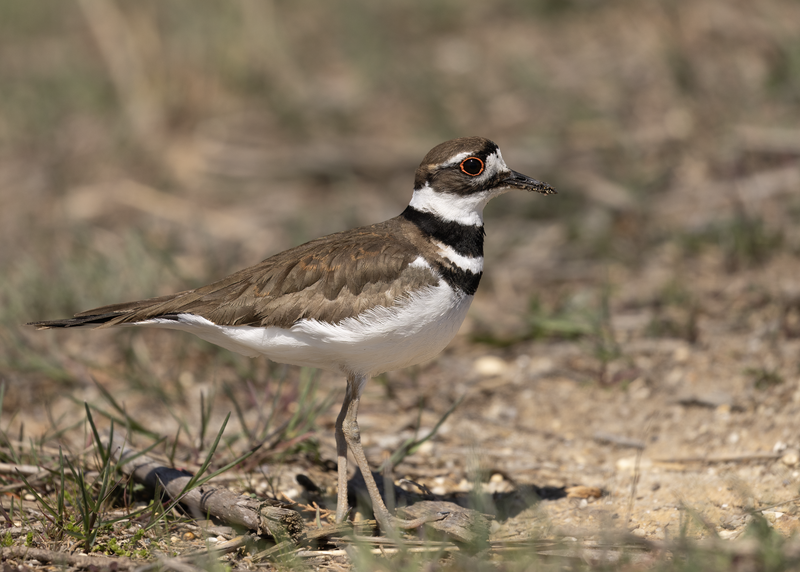
The Killdeer is a type of large plover, a shorebird found in the Americas. It is easily recognized by its shrill, two-syllable call, which can often be heard in its natural habitats.
Killdeer were first documented in the 10th edition of the Systema Naturae, a book written by the Swedish botanist Carl Linnaeus in 1758. Three subspecies of Killdeer have been described and identified since then, each varying slightly in size and color.
The Killdeer is a unique bird, with its distinctive call and features, making it a fascinating species to study and observe.
| Kingdom | Animalia |
| Phylum | Chordata |
| Class | Aves |
| Order | Charadriiformes |
| Family | Charadriidae |
| Genus | Charadrius |
| Species | C. vociferus |
16. American Robin
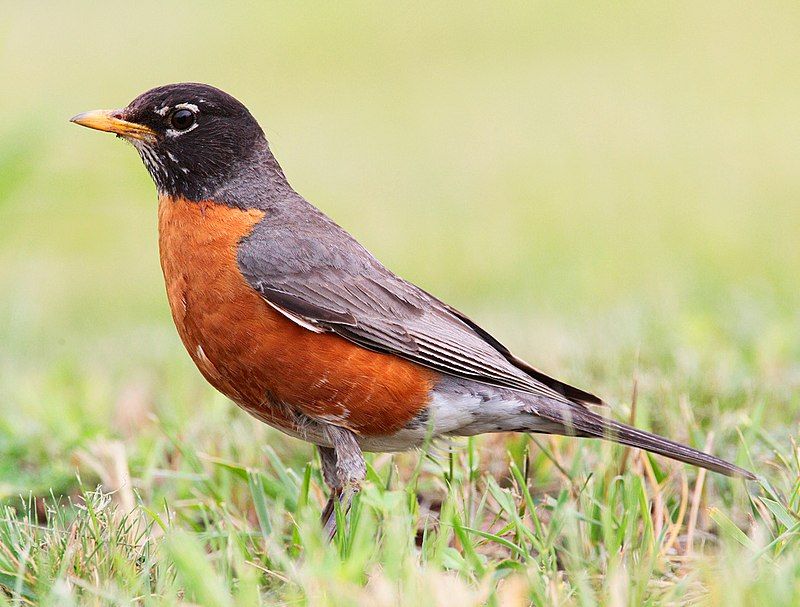
The American robin is a species of migratory bird that is part of the true thrush genus and the larger thrush family, Turdidae. It was named after the European robin due to its reddish-orange breast, although the two bird species are not closely related.
The European robin is actually part of the Old World flycatcher family. This shows that the two species have different evolutionary lineages and do not share a common ancestor.
The American robin is found in North America, while the European robin is found in Europe and parts of Asia. The American robin is a beloved species in the United States, often seen in backyards and parks, and is the state bird of Connecticut, Michigan, and Wisconsin.
| Kingdom | Animalia |
| Phylum | Chordata |
| Class | Aves |
| Order | Passeriformes |
| Family | Turdidae |
| Genus | Turdus |
| Species | T. migratorius |
17. Golden-crowned Sparrow
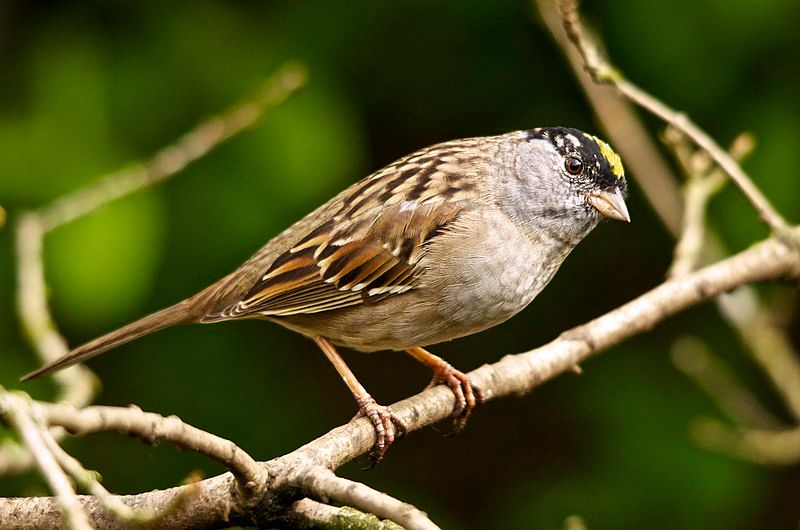
The golden-crowned sparrow is a unique bird species that is native to the western part of North America. It belongs to the family of New World sparrows, which includes other species such as the white-crowned sparrow and the dark-eyed junco.
This species of sparrow has a distinctive yellow stripe that extends from the top of its head down to its back. This yellow streak is what gives the golden-crowned sparrow its name. The golden-crowned sparrow is a large bird, with an average length of around 7 inches.
It has a gray-brown back, with white underparts and a black bill. They also have yellow lores and a white eye ring. The male and female birds look similar, but the males have darker crowns and more yellow on the lores than the females.
During the breeding season, the males will have a darker crown than the females. The golden-crowned sparrow is found in a variety of habitats, from open fields and meadows to shrubby areas and woodlands. They typically feed on grass seeds, insects, and berries.
They also like to take advantage of bird feeders in urban areas. They are often seen in flocks during the winter months, and they migrate south for the winter.
The golden-crowned sparrow is an important species for its beauty, and it serves as an important source of food for many predators. They are also important to the environment, as they help spread seeds and improve soil fertility.
With their distinct yellow stripe, the golden-crowned sparrow is a species that is sure to be appreciated by bird watchers around the world.
| Kingdom | Animalia |
| Phylum | Chordata |
| Class | Aves |
| Order | Passeriformes |
| Family | Passerellidae |
| Genus | Zonotrichia |
| Species | Z. atricapilla |
18. White-crowned Sparrow
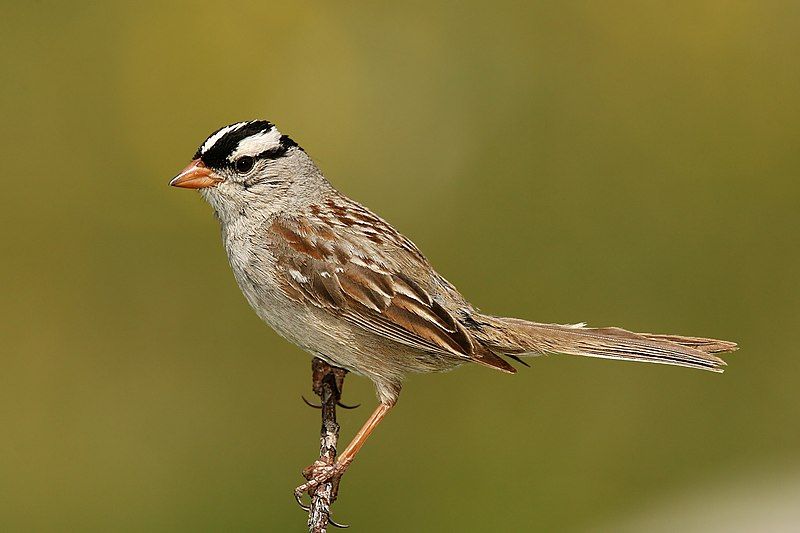
The white-crowned sparrow is a species of bird that is native to North America. It belongs to the family of New World sparrows, which is characterized by its medium size and distinctive grey face.
This species is further distinguished by its black and white streaking on the top of its head. The white-crowned sparrow is a fairly common bird in North America and can be found in a variety of habitats, from deserts to mountains and forests.
It feeds on both insects and seeds and is known to sing a variety of melodic songs. The white-crowned sparrow is an important part of the North American avian ecosystem and is a welcome addition to any backyard or nature reserve.
| Kingdom | Animalia |
| Phylum | Chordata |
| Class | Aves |
| Order | Passeriformes |
| Family | Passerellidae |
| Genus | Zonotrichia |
| Species | Z. leucophrys |
19. Sandhill Crane
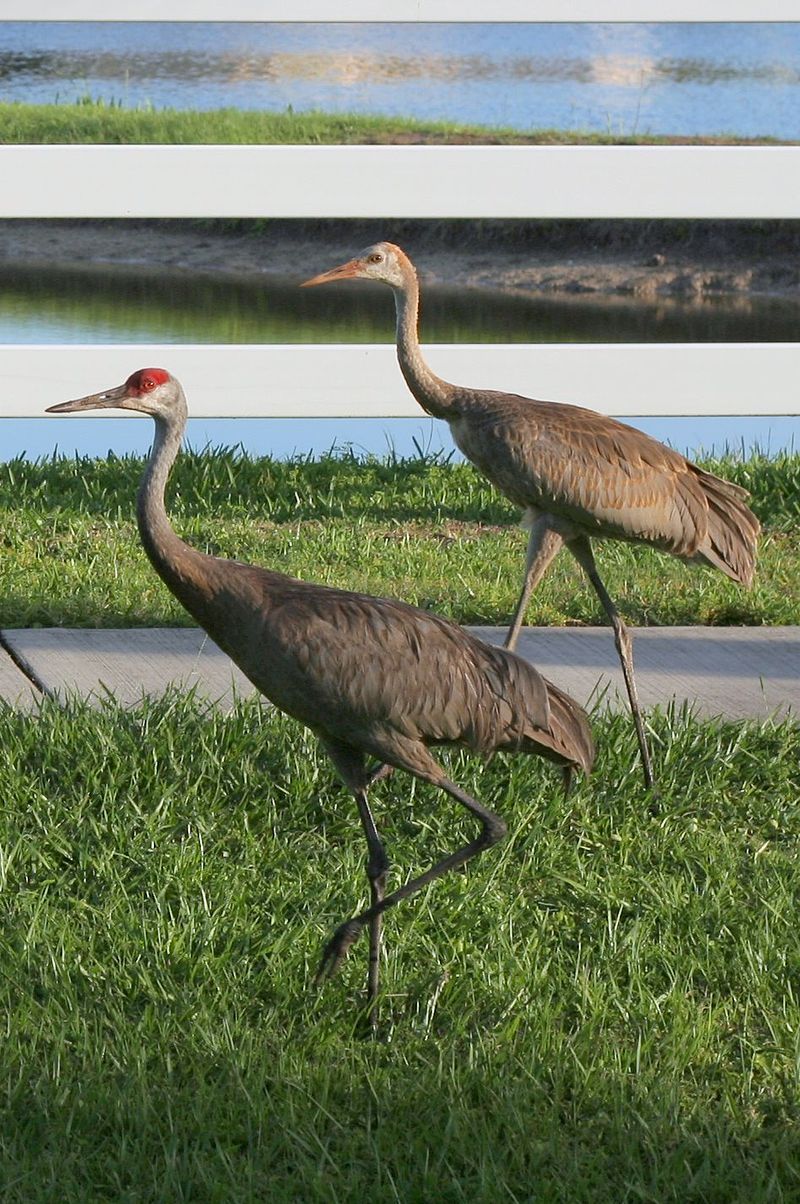
The sandhill crane is a species of large crane typically found in North America and northeastern Siberia. It is known for its presence in habitats such as the Platte River, located on the edge of Nebraska’s Sandhills in the American Great Plains.
The species is easily identified by its long legs, long neck, and greyish-brown plumage. Sandhill cranes have also been known to inhabit wetlands, grasslands, and agricultural areas. The sandhill crane is a unique species for a variety of reasons.
Firstly, it has a very distinct call that can be heard from up to two miles away, which is used to communicate with its flock members.
Secondly, it is one of the oldest living bird species, with fossil evidence suggesting that they have been around for over two million years. In addition, the sandhill crane is an important species in North America, as it plays a critical role in maintaining the health of wetlands and grasslands.
It feeds on a variety of plants, insects, and small animals, and its presence helps to keep these habitats healthy.
Furthermore, its migration patterns are an important part of many ecosystems, as the cranes travel great distances to reach their breeding grounds. Overall, the sandhill crane is an important species that plays a critical role in North America’s ecology.
It is easily recognizable by its distinctive call, long legs, and greyish-brown plumage, and is found in a variety of habitats in both North America and Siberia.
Its presence helps to maintain the health of wetlands and grasslands, and its migration patterns are an important part of many ecosystems.
| Kingdom | Animalia |
| Phylum | Chordata |
| Class | Aves |
| Order | Gruiformes |
| Family | Gruidae |
| Genus | Antigone |
| Species | A. canadensis |
20. Bufflehead
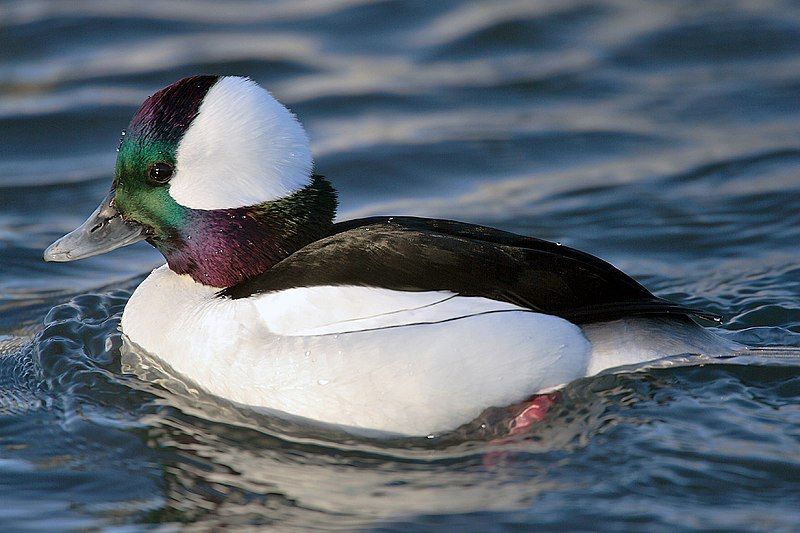
The bufflehead is a small sea duck belonging to the genus Bucephala, which is commonly known as goldeneyes. This species was first identified by famous biologist Carl Linnaeus in his 1758 10th edition of Systema Naturae as Anas albeola.
The bufflehead is a migratory species, primarily breeding in North America and wintering in the coastal waters of the Pacific, Atlantic, and Gulf of Mexico. It is a small sea duck, with a short neck and a round head, and males and females have distinct plumage.
Males have a glossy green head and white neck and breast, while females are brownish-gray with a white patch on the cheek. This species is an opportunistic feeder, eating aquatic invertebrates, mollusks, crustaceans, and small fish.
It is also known to feed on berries, grains, and seeds. The bufflehead is an important species for sport hunters in North America, and its population is currently stable.
| Kingdom | Animalia |
| Phylum | Chordata |
| Class | Aves |
| Order | Anseriformes |
| Family | Anatidae |
| Genus | Bucephala |
| Species | B. albeola |
21. Northern Shoveler
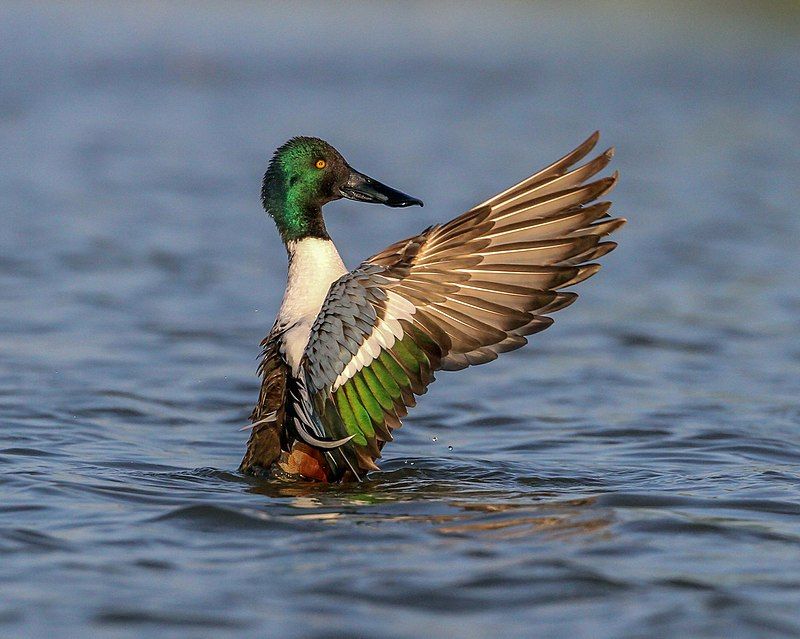
The northern shoveler, also known as the shoveler, is a widespread and common duck. It is found in a variety of locations across Europe and Asia, including northern Europe, the Palearctic, and most of North America.
During the winter months, it migrates to areas such as southern Europe, the Indian subcontinent, Southeast Asia, Central America, the Caribbean, and northern South America. The species is highly adaptable, able to thrive in a variety of different habitats.
It primarily feeds on aquatic insects, which it obtains by filtering water through its bill. The northern shoveler is a popular bird for bird watchers and is a common sight in many areas.
| Kingdom | Animalia |
| Phylum | Chordata |
| Class | Aves |
| Order | Anseriformes |
| Family | Anatidae |
| Genus | Spatula |
| Species | S. clypeata |
22. Calliope Hummingbird
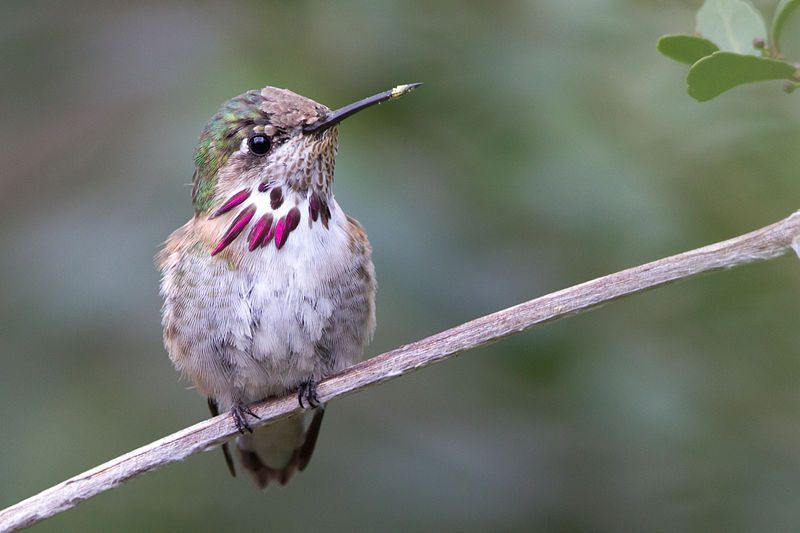
The calliope hummingbird is an incredibly small bird native to North America and is the smallest bird species found in the United States and Canada.
It typically breeds in the western regions of both countries, mainly in California and British Columbia, and then migrates to other parts of the continent for its winter home.
During the cold winter months, the calliope hummingbird travels to the Southwestern United States, Mexico, and Central America, where the climate is milder and more suitable for its survival.
The calliope hummingbird is quite unique in the avian world since it is the smallest species of bird in North America. It is about 3.5 inches in length, with a wingspan of 4.3 inches, making it one of the tiniest birds in the world.
Its body is mostly gray in color, with a white throat and a few white spots on its wings. The male’s throat feathers are also typically bright red or orange.
The calliope hummingbird feeds on small insects and nectar from flowers and can be seen hovering in mid-air while feeding. It is also a strong flier and can fly up to 30 miles per hour.
The calliope hummingbird is an important species in its native range, as it pollinates many of the plants it feeds on. It is also an important indicator of the health of its habitats, making it an important species to monitor and protect.
| Kingdom | Animalia |
| Phylum | Chordata |
| Class | Aves |
| Clade | Strisores |
| Order | Apodiformes |
| Family | Trochilidae |
| Genus | Selasphorus |
| Species | S. calliope |
23. Harlequin Duck
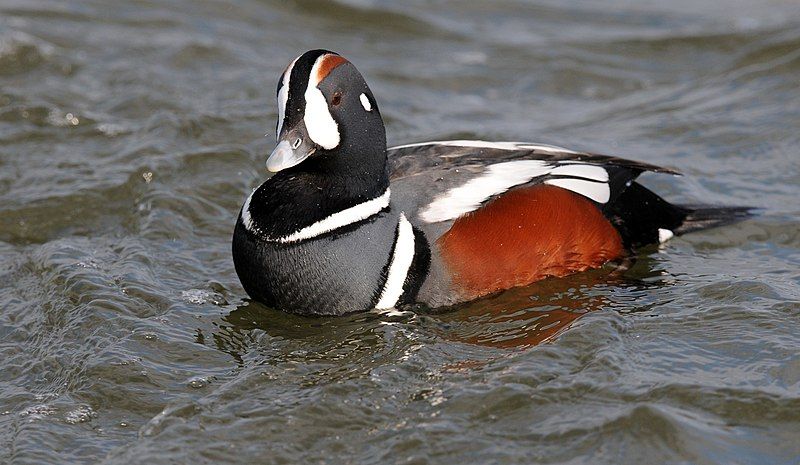
The harlequin duck is a small sea duck found throughout much of the northern hemisphere. Its name is derived from Harlequin, a popular character in the Commedia dell’arte, a form of Italian theatre.
The name of the species also comes from the Latin word “histrio”, which means “actor”. In North America, the duck is also known as lord and lady.
The harlequin duck has a distinctive coloration; its body is marked with a variety of bright colors, which is likely where it gets its name from. The bird has a unique adaptation to its environment, as it is able to dive for food and spend long periods of time underwater.
It is a popular species of duck among birdwatchers, due to its unique coloring and behavior.
| Kingdom | Animalia |
| Phylum | Chordata |
| Class | Aves |
| Order | Anseriformes |
| Family | Anatidae |
| Genus | Histrionicus |
| Species | H. histrionicus |
24. California Scrub Jay
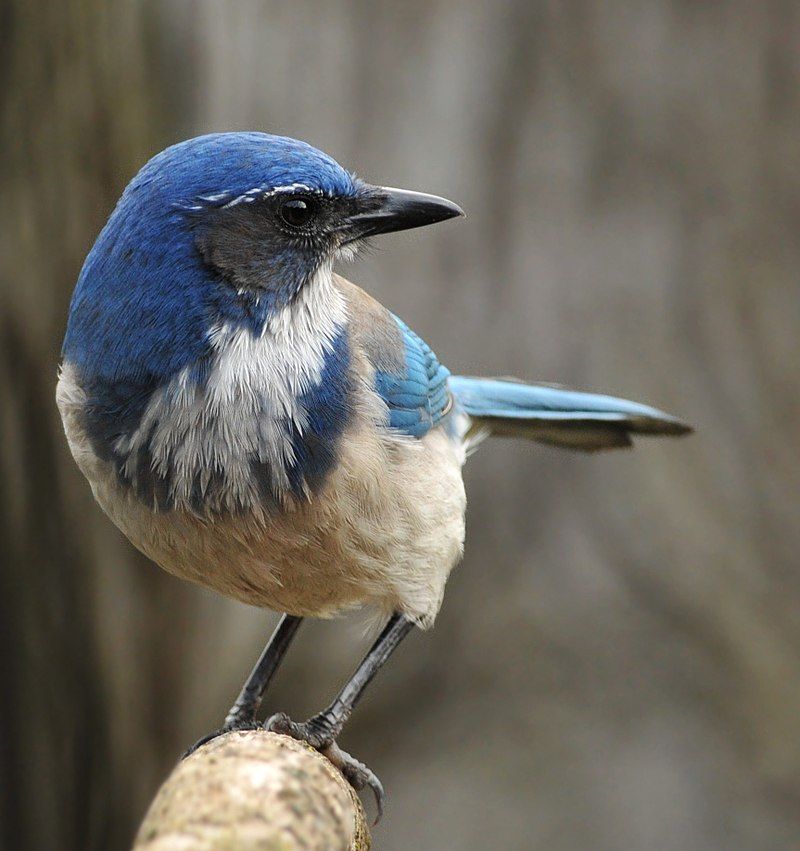
The California Scrub Jay is a bird species that is native to the western side of North America, ranging from British Columbia in the north to California and western Nevada near Reno, and also to the west of the Sierra Nevada.
This bird species can be found in a variety of habitats, including chaparral, conifer forests, oak woodlands, and coastal sage scrub. These birds are omnivorous, eating a variety of items such as insects, fruits, nuts, eggs, nestlings, and also carrion.
These birds are also known to cache, or hide, food items for later use. They are considered to be non-migratory, meaning they remain in their habitats year-round.
The California Scrub Jay is an important part of the food chain, providing a food source for other animals, as well as helping to keep insect populations in check. They are also important in helping to disperse seeds, aiding in the growth of native plants in their habitats.
| Kingdom | Animalia |
| Phylum | Chordata |
| Class | Aves |
| Order | Passeriformes |
| Family | Corvidae |
| Genus | Aphelocoma |
| Species | A. californica |
Conclusion
Birds in Fresno are a remarkable part of the city’s wildlife diversity. They bring beauty to the city’s outdoor spaces and provide a source of entertainment and delight to local residents and visitors alike.
From the small and colorful House Finch to the majestic Bald Eagle, birds in Fresno provide a unique and wonderful experience to those who take the time to observe them.